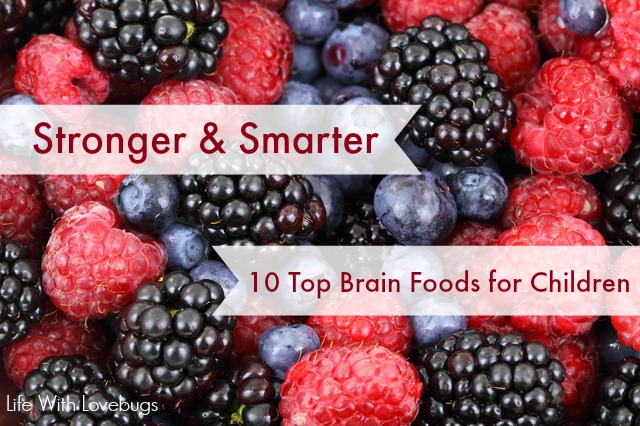Stronger & Smarter: 10 Top Brain Foods For Children

The brain is the first of the body’s organs to absorb nutrients from the food eaten. A child’s nutritional palate has everything to do brain function, memory, and concentration. Studies prove time and time again that there is a great positive correlation with the types of foods children eat and their mood, attention spans, behavior, and test scores. Below are top super “brain foods” that may help boost a child’s brain development and growth.
1. Wild Salmon
Fatty fish, like wild salmon, is an excellent source of the omega-3 fatty acids DHA and EPA — both essential for brain growth and function. Research shows that people who get more of these fatty acids in their diet have sharper minds and do better on mental skills tests.
Instead of tuna sandwiches, make salmon salad for sandwiches – try non canned-but bag packaged salmon mixed with reduced-fat mayo or nonfat plain yogurt, raisins, chopped celery, and carrots (plus a little sweet Dijon mustard if your child likes the taste). Serve on whole-grain bread, naan, pita bread or whole-grain crackers — which are also a brain foods.
2. Free Range Eggs
Free Range Eggs is a great clean protein source — but the egg yolks are the best brain building part. They are packed with choline, which helps memory development.
Make a scramble: homemade grab-and-go breakfast egg burrito or put a little on some avocado and toasted whole grain slice of bread with some melted cheese. Hard boiled eggs are not only easy to make, they are convenient to take anywhere and eat. Chinese people like to make scrambled eggs with a little sautéed tomatoes and soy sauce on top of white rice.
Tomatoes, sweet potatoes, pumpkin, carrots, spinach — vegetables with rich, deep color are the best sources of antioxidants that keep brain cells strong and healthy, Thayer says.
3. Veggies
Eat more veggies: Try healthy sweet potato fries. Cut up in thin wedges or sticks. Spray them with olive oil cooking spray or coat them with coconut oil and then bake them in the oven (400 degrees, 20 minutes or until they start to brown).
Baby carrots and tiny tomatoes fit nicely into lunch bags. Kids love wilted spinach salads with lots of yummy colors in them, like strawberries, mandarin oranges, craisens and sliced almonds. Sneak all sorts of chopped veggies into spaghetti sauce, soups, and stews, like zucchini and avocado for a creamier consistency.
4. Nut butters: Peanut and Almond Butter
Nut butters are great sources of vitamin E, a potent antioxidant that protects the brain and nervous membranes — plus thiamin to help the brain and nervous system use glucose for energy.
Aside from traditional peanut butter and banana sandwiches, dip apple slices, carrots or pretzels in peanut butter. Put a dollop in oatmeal or smear some on waffles with syrup. Children love crunchy granola with raisins and peanuts mixed in as well.
5. Whole Grains
The brain needs a constant supply of glucose — and whole grains provide that in spades. The fiber helps regulate the release of glucose into the body, and whole grains have a good source of B vitamins, which nourish a healthy nervous system.
When shopping for whole-grain cereals, make sure a whole grain is the first ingredient listed. Try whole wheat couscous for dinner with cranberries, and experiment with more grains than just wheat, such as amaranth, buckwheat, sesame, oat bran, rye and flax. Make a healthy switch to whole-grain tortillas and chips for quesadillas, wraps, and snacks.
6. Oats
Oats are one of the most popular hot cereals for kids and sometimes labeled as a “grain for the brain.” They provide excellent energy or fuel for the brain that kids need first thing in the morning.
Loaded with fiber, oats keep a child’s brain fed all morning at school. Oats also are a great source of vitamin E, B vitamins, potassium, and zinc, which make our bodies and brains function at optimal capacity.
Try topping hot oatmeal with different delicious sprinkles of cinnamon and applesauce, dried fruit and almond milk, sliced almonds and a drizzle of honey, agave with fresh banana and a dash of nutmeg with skim milk, or peanut butter and soy milk.
7. Berries
Including strawberries, cherries, blueberries, blackberries and raspberries. As a general note, the more intense the color, the more nutrition in the berries. Berries boast high levels of antioxidants, especially vitamin C, which may help prevent cancer.
Studies have shown improved memory with the extracts of blueberries and strawberries. Remember to eat the real thing to get a more nutritious package. The seeds from berries are a good source of omega-3 fats and provide fiber. Pureed packages of processed fruits and vegetables do not provide minerals and vitamins like the fresh ones do, and do not teach children to get in the habit of eating and liking real foods.
Eat more berries: Add berries to veggies that may need a flavor boost — like sliced sweet cherries with broccoli or strawberries with green beans. Don’t forget about those refreshing smoothies with kefir or Greek yogurt, bananas and ice for a summertime treat. Add chopped strawberries and kiwi to a jar of salsa for an excellent flavor surprise. Buy organic when possible, or local and seasonal. Frozen, unsweetened berries are fine when the fresh ones are not available.
8. Beans
Beans are special because they have energy from protein and complex carbs — and fiber — plus lots of vitamins and minerals. These are an excellent brain food since they keep a child’s energy and thinking level at peak all afternoon if they enjoy them with lunch.
Kidney and pinto beans contain more omega-3 fatty acids than other beans — specifically ALA, another of the omega-3s important for brain growth and function.
Sprinkle beans over a salad, eggs, or mashed inside a tortilla with cheese. Add beans to spaghetti sauce or in soups. Infants tend to love mashed beans with applesauce!
9. Milk/Dairy Products
Dairy foods are packed with protein and B vitamins — essential for growth of brain tissue, neurotransmitters, and enzymes. Milk and yogurt also provide a bigger punch with both protein and carbohydrates — the preferred source of energy for the brain. Recent research suggests that children and teens need 10 times more than the recommended dose of vitamin D — a vitamin that benefit the neuromuscular system and the overall life cycle of human cells.
Eat more dairy: Low-fat milk over cereal and calcium- and vitamin D-fortified juices are easy ways to get these essential nutrients. Cheese sticks are great, portable snacks.
10. Quinoa
Quinoa (pronounced “keen-wah”![]() is one of only two vegetarian sources of complete protein (soy is the other), meaning that it contains all the essential amino acids. These tiny nutty and delicious rice-alternative can be mixed with oatmeal, brown rice or eaten alone with sprinkles of parmesan cheese. Use the quinoa grain (similar to couscous) as a substitute for rice or pasta in any dish!
is one of only two vegetarian sources of complete protein (soy is the other), meaning that it contains all the essential amino acids. These tiny nutty and delicious rice-alternative can be mixed with oatmeal, brown rice or eaten alone with sprinkles of parmesan cheese. Use the quinoa grain (similar to couscous) as a substitute for rice or pasta in any dish!
Dr. Nancy Lin DeGreogori, Ph.D


